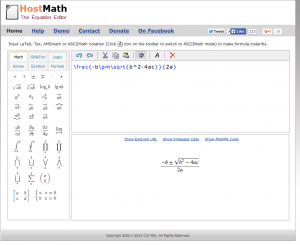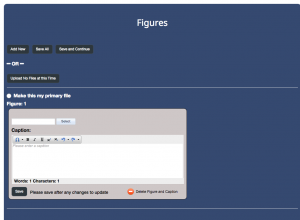How to Submit Your HTML-Based Abstract
for the 2021 Annual Meeting
If you are reading this, you are likely preparing your first SMRT abstract using the HTML submission system. This process should be rather straightforward, but we would like to walk you through this step by step. Note: The example images shown here are from an ISMRM submission. It is representative of what your abstract should look like when completed.
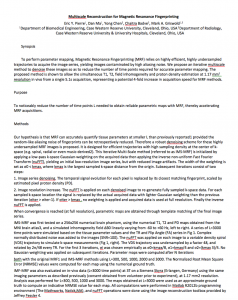 The best way to prepare your abstract for submission is to write and organize your text in any common text editor (e.g. Microsoft Word, iWorks or even vi) without any special formatting. Each section will be entered individually separated by a section header. There is an 850 word limit for the total abstract length. Please note that this number only includes the body of the text, and does not include references, acknowledgements, synopsis or figure captions. You will also need an up-to 100 word synopsis, but this will be added on a separate page. Each abstract can have up to 5 figures. Individual figure captions should be limited to 500 characters. There is no limit to the format of the figures except that they should be less than 2MB in size. The figures will be viewed in an HTML browser, so zooming and panning should be possible as implemented by the browser used by the reader. Please note that both the synopsis and the acknowledgement sections will appear on the preview and on the final abstract, but these will not appear during the review process.
The best way to prepare your abstract for submission is to write and organize your text in any common text editor (e.g. Microsoft Word, iWorks or even vi) without any special formatting. Each section will be entered individually separated by a section header. There is an 850 word limit for the total abstract length. Please note that this number only includes the body of the text, and does not include references, acknowledgements, synopsis or figure captions. You will also need an up-to 100 word synopsis, but this will be added on a separate page. Each abstract can have up to 5 figures. Individual figure captions should be limited to 500 characters. There is no limit to the format of the figures except that they should be less than 2MB in size. The figures will be viewed in an HTML browser, so zooming and panning should be possible as implemented by the browser used by the reader. Please note that both the synopsis and the acknowledgement sections will appear on the preview and on the final abstract, but these will not appear during the review process.
We have found that individual Greek characters come across when copied from Microsoft Word. However, since the abstract will be rendered in HTML, equations are a separate issue. These will be entered using MathJax. For those who are unfamiliar with MathJax or those used to working in e.g. MathType, there are several equation toolboxes on the web. One suggestion is HostMath. To use tools such as this, you can use the buttons on the left to enter the mathematical symbols you need. You can constantly see an update of what your equation will look like on the right. Once you are satisfied with the equation, copy all of the text in the upper window to your document so that you can access it during the submission process.
Once you are ready to submit, you can go to the link at the bottom of the Call for Abstracts page to start the submission process. We have been advised that users should NOT have multiple tabs open at the same time.
You must create a NEW ACCOUNT the first time you visit the submission site for the 2021 Annual Meeting. To do this, click “New to this site?” on the submission site login page. Any accounts you created in past years will not work on this meeting’s submission site.
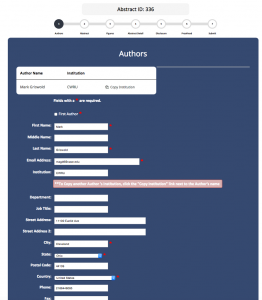 On the next page you will be able to “Create a new abstract” which is where we will pick up the story.
On the next page you will be able to “Create a new abstract” which is where we will pick up the story.
The first task is to input all of the authors on the abstract. Please note the “First Author” box near the top. This box has to be checked for at least one author.
On the next page we get to the core of the submission process. In this window, you start with the title at the top. All you need to do is paste the text into this window. All formatting will be stripped from this text.
We require a 100-word synopsis. This will be placed on the app and online proceeding if your abstract is accepted.
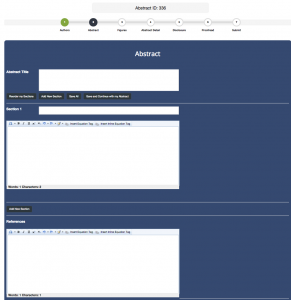 Below this, the abstract is broken into separate sections.
Below this, the abstract is broken into separate sections.
Please use the suggested section titles:
Clinical Practice Focus
- Background
- Teaching Point
- Summary or Conclusions
- References
Research Focus
- Background or Purpose
- Methods
- Results
- Conclusions
- References
We have already included sections for “References” and “Acknowledgments”. In the final document, all of these section titles will appear in a different font compared to the body of the text. Below the section title, there is a simple text box where the body text is entered. Again, it is best to copy and paste the text from your editor directly. As with the title, any other formatting that you copied in from your previous document will be stripped. However, in this section, you can also add bold, italic and other formatting to your text.
Please click “Save All” often to ensure that you don’t lose your work.
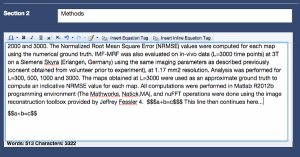 In the upper right part of this text entry box, you can also see two different options for entering equations into the text. The first option is for an offset equation which is an equation that will be displayed on a line by itself. The section option is for an inline equation that will appear in the body of the text. There are two buttons to insert the flags for these two options. The “Insert Equation Tag” inserts a “$$” symbol, while the “Insert Inline Equation Tag” inserts a “$$$”.
In the upper right part of this text entry box, you can also see two different options for entering equations into the text. The first option is for an offset equation which is an equation that will be displayed on a line by itself. The section option is for an inline equation that will appear in the body of the text. There are two buttons to insert the flags for these two options. The “Insert Equation Tag” inserts a “$$” symbol, while the “Insert Inline Equation Tag” inserts a “$$$”.
Please note that you need to have these tags on both ends of your equation or it won’t show up correctly.
As you can see in the figure above, the format should be $$a+b=c$$ for offset equations or $$$a+b=c$$$ for inline equations. Thus the way you get your MathJax equation into this document is to paste the text you copied from HostMath in between these symbols. For example, $$\frac{-b\pm\sqrt{b^2–4ac}}{2a}$$.
Once you are done with your first section, you can add more sections by clicking the “Add Section” button. This will give you another box to enter the section title and the body text for the next section. Continue this process until you are done entering all of the text. Once you’re done, hit “Save and continue with my abstract.” Again, there is an 850 word limit on the abstract length.
Please note that there will be a separate place to enter your synopsis, so please don’t dedicate a section to the synopsis here.
Once you are done entering the text, it’s time to upload your figures. These are done on the next screen. As you might guess, you start by hitting “Add New”. This gives you a separate gray area where you can select a file to upload and enter the figure caption. The system does not automatically number the figure and table captions. Please add something like “Figure 1:” or “Table 1:” when you type in the caption. As a first step, hit the “Select” button at the top. This will bring up a window where you can point to the file on your local machine. These files can be in many formats including jpeg, gif, etc. Once the file is uploaded, you can enter the caption. Once you are done with the caption, hit “save” in the gray area to accept the file and caption. You should see a small preview appear in the gray area. You can upload up to 5 figures for each abstract. Figure captions are limited to 500 characters each. There is a maximum file size of 2MB for each figure. Finally, please upload tables as figures.
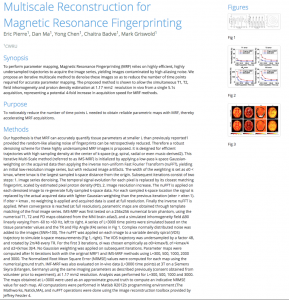 There is an additional button “Make this my primary file.” This must be checked for at least one figure in your abstract.
There is an additional button “Make this my primary file.” This must be checked for at least one figure in your abstract.
Next, you will need to upload your CV file, select your track, indicate whether you are applying for the JAK Award, and select your presentation preference.
Once you are finished with this, you should end up with a nicely formatted responsive HTML document like the example on the right.
If you would like an archival PDF of your abstract, please click the Print button. This will generate a PDF version of your HTML abstract.
For a walkthrough of the process, watch this video by Mark Griswold and Shawna Farquharson from the 2020 meeting.


